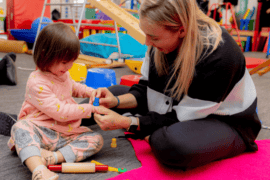Deciphering Baby Cues: An Essential Guide for Parents
Introduction
Hello there, lovely parents! Isn’t it exciting and yet quite a challenge to understand your little bundle’s language? No worries, this friendly guide is here to assist you in interpreting your baby’s behaviors, which are their unique method of communication. It’s a delight to reveal to you the secret language of babies!
Why Understanding Baby Cues is Important
Recognizing and responding to baby cues is a pivotal part of parenting. It strengthens the parent-infant bond and supports the baby’s emotional, social, and cognitive development. So, let the journey of understanding your baby’s cues begin!
Understanding Different Types of Baby Cues
Our cutie-pie little ones are undoubtedly expressive, aren’t they? Their gestures, expressions, and sounds hold specific meanings. Understanding these can help you meet their needs and keep them content.
1. Hunger Cues
Tummy rumbles, and it’s time to feed! But how will our infants tell us they’re hungry? Here are some cues:
- Early Cues: Sucking fingers, smacking lips, and turning heads towards objects or fingers (also known as rooting)
- Active Cues: Fussing, squirming, and hitting you on the arm or chest repeatedly
- Late Cues: Crying, a clear signal you’ve got a really hungry little one at hand!
2. Sleep Cues
Sleepy signals differ from kid to kid. However, here are some general markers that indicate it’s time for some dreamland magic:
- Early Cues: Yawning, slowing down, and losing interest in people and toys
- Active Cues: Rubbing eyes, getting fussy, and showing signs of hyperactivity
- Late Cues: Crying or hard-to-calm behavior. This generally means the baby is overtired
3. Engagement Cues
Wondering if your bub is ready for some playtime or learning? Look out for these cues:
- Bright-eyed, alertness, and orienting toward interesting visuals
- Reaching out, or ‘asking’ to be picked up
- Coos, babbles, or excited kicks during an activity
4. Overstimulation Cues
If your little munckin seems overwhelmed, anxious, or needs a breather, they may show these overstimulation signals:
- Averting eyes, yawning (even if not sleepy), pulling away
- Sudden frantic movements or frowning
- Fussing or crying despite being well-fed and not sleepy
To be continued…
Hush now, a whole new world of baby communication is opening before you! This is just a beginning, and there’s much more to learn. Stay tuned for more practical insights!

Credit: Pexels
More Essential Baby Cues and Communication Strategies
Let’s continue our exploration, shall we? Your journey in parenting will be enriched as you further master the language of baby cues!
5. Discomfort or Distress Cues
Comforting a distressed baby is a lot easier when you know what’s bothering them. Here’s how they might communicate discomfort:
- Whining, whimpering, or general irritability
- Expressive facial cues like gasping, grimacing, or frowning
- Sudden changes in body movements or temperature
- Increased fussiness or crying that doesn’t resolve with food or sleep
6. Contentment Cues
Aren’t we all living for those heart-melting smiles? Look out for these cues to know your little one is happy and well:
- Relaxed body and smooth movements
- Smiling, cooing, or even laughing
- A general interest in their surroundings
Different Stages of Communication
As your little one grows, so will their methods of communication. Let’s look at how baby cues evolve:
- Newborns: They primarily use crying, eye movements, and basic body language.
- 3-6 months: They start using sounds, smiles, and more expressive body language.
- 6-12 months: Babbling, gesturing, and some actual words are added to their communication toolkit!
Conclusion
Your baby is a unique little individual. The specific cues they use may vary but understanding these general cues will enable you to respond accurately and build stronger bonds. And remember, if their cues seem inconsistent or confusing, trust your parental intuition. You’re doing an amazing job!
Here’s a hearty cheer and a sprinkle of comfort on your beautiful journey of parenievalthood! Let’s continue to revel in the joys of understanding our babies a little better each day.
Understanding Baby Cues for Effective Communication
As a new parent, it’s important to learn and understand your baby’s cues for effective communication. Babies have unique ways of expressing their needs, and identifying them on time is crucial. Here are the top five things you ought to know when preparing for baby cues in communication:
1. Different Types of Crying
Babies communicate predominantly through crying. Therefore, identifying the difference between the cries is crucial. Some could signal hunger, discomfort, need for sleep, or just a need for attention. Knowing the difference will help you meet your baby’s needs promptly.
2. Use of Gestures
Babies also use body language and facial expressions to communicate. These can be subtle movements like turning their head towards something they want or making a fist when they are upset. Be observant and responsive to these cues.
3. Eye Contact and Smiling
Eye contact and smiling are powerful forms of communication used by babies. When babies gaze at you and maintain eye contact, it’s their way of demanding your attention and response.
4. Responding to Sounds
Babies typically respond to sounds and voices they are familiar with. They might turn their heads towards the direction of the sound or cease crying when they hear familiar voices. Use this cue to bond and interact with your baby.
5. Sleep and Hunger Cues
A major part of baby communication revolves around their basic needs: hunger and sleep. Yawning, fussiness, and rubbing eyes could be sleep cues, whereas hand-to-mouth movements or sucking on their own fingers indicates hunger.
Preparing for and understanding these baby cues is a journey. Patience, observation, and continuous learning are key in strengthening that parent-child bond through effective communication.
For more great articles please see here. For more information on raising children see here
Disclaimer
The articles available via our website provide general information only and we strongly urge readers to exercise caution and conduct their own thorough research and fact-checking. The information presented should not be taken as absolute truth, and, to the maximum extent permitted by law, we will not be held liable for any inaccuracies or errors in the content. It is essential for individuals to independently verify and validate the information before making any decisions or taking any actions based on the articles.




